Cholets: Opulent Neo-Andean Architecture
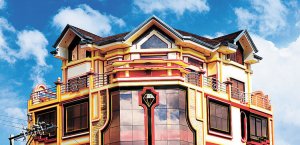
Cholets are a product of opulent Andean architecture. The buildings that arise from this neo-style are unmistakable thanks to their colors and geometric designs. In addition to their uniqueness, cholets have become a hot architecture trend in the Andean highlands.
The new style results from Freddy Mamani’s tireless search for a way to express contemporary Andean identity. Prior to becoming an engineer and builder, Mamani worked as a mason.
Freddy Mamani’s search focuses on the city of El Alto, which is located on the outskirts of La Paz, Bolivia. The rapidly-growing city is a product of the migration from the countryside of Bolivia.
More than fifty years ago, the first settlers made El Alto their home. Since then, a bourgeoisie Aymara population has been growing and growing. And Freddy Mamani is their choice architect.
Freddy Mamani, the self-taught architect
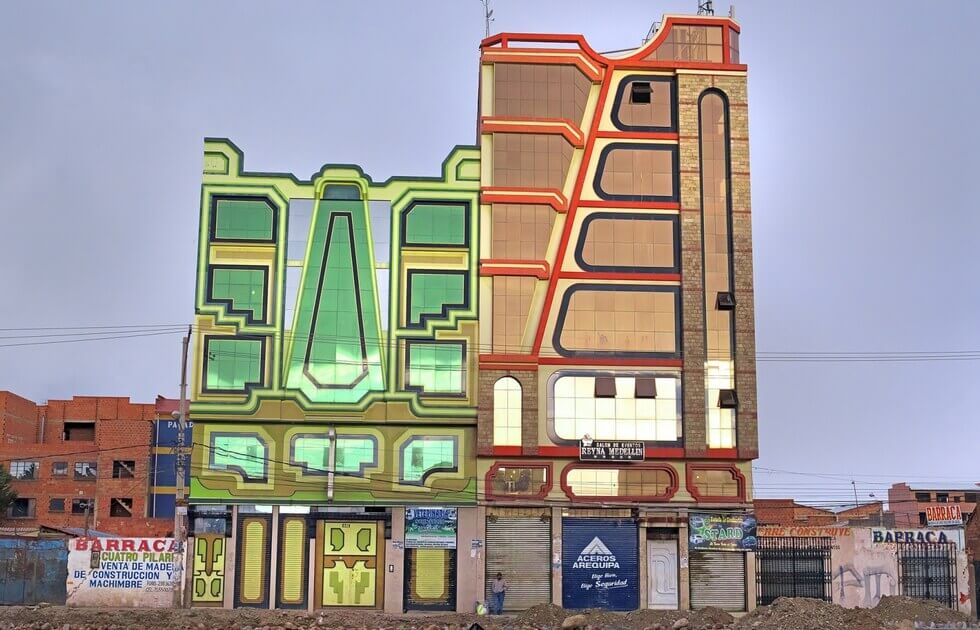
The Bolivian architect was born in the small Aymaran community of Catavi in the Aroma region of La Paz. He started working around 20 years ago as a mason’s assistant.
After his years in masonry, he decided to specialize and studied civil construction at the Universidad Mayor de San Andres. After completing his studies, he studied for a degree in Civil Engineering at the Universidad Bolivia de Informatica and studied architecture on his own.
The neo-Andean cholet style was on the road to success from the beginning. It all started when Francisco Mamani, a commercial telephone importer, wanted to construct a building. Without even knowing how he wanted to build it, he contacted Freddy Mamani.
Freddy then suggested building something elegant with Andean motifs and colors as well as a big room for events. The design implied a big change for the city as there would be no buildings like it. But, after its completion, there were more than 70 similar creations.
These buildings feature six levels and take center stage in El Alto’s urban scene. Their bright color palette is the first thing to catch the eye.
The colors are impossible to miss as the buildings in Al Alto are constructed with exposed bricks. The bricks create a monochrome, cold and dry backdrop for the city.
My architecture isn’t an exotic architecture; instead, it’s an Andean architecture that transmits identity and recuperates the essence of a culture.
–Freddy Mamani–
Cholets – the opulent neo-Andean architecture of the Aymaran Bourgeoisie
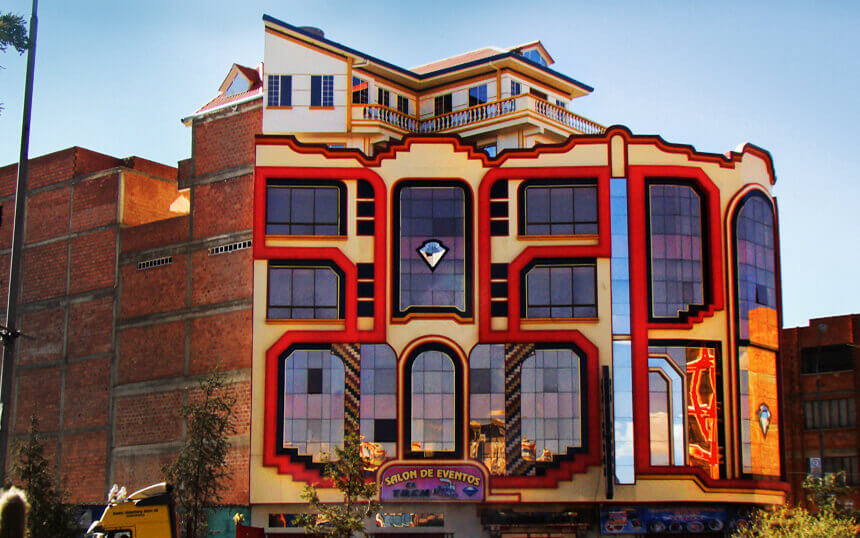
All through its history, El Alto has welcomed thousands of migrants from Bolivia’s countryside. More than fifty years of growth has armed a new Aymara upper-middle class.
This new class saw Freddy Mamani, and his services, as an exceptional talent. He found the Aymaran identity, architecture, and culture in his work. Freddy Mamani once stated, “I want to give my city identity by recovering the elements of our original culture.”
Cholets, which come from a mash-up of the Spanish words “chalet” (a type of house) and “cholo” (a term of national identity), now dot the Andean highlands. They feature large glass windows on exterior walls with plastic compositions of plaster molds.
The exterior walls feature spontaneous, modern geometric motifs in sweeps of complementary, bright colors. The most common colors are orange, green, blue and yellow.
Aymarans believe that homes are a universe in constant movement that should never stand still. Thus, they always need to be full of life through celebrations. Celebrations also bless with wealth, which helps the community. As a result, cholets are often buildings that serve multiple purposes.
These almost psychedelic-looking buildings actually draw their inspiration from the colors of aguayos. Aguayos are tapestries that Aymaran women use for a variety of uses.
But as a consequence following a cultural search instead of following academic standards, Freddy Mamani’s architecture received harsh criticism. In any case, the architect doesn’t seem to bat an eye and has stated, “I’ve broken the old architectonic norms and, yes, I am guilty.”
The Aymaran identity in cholet architecture
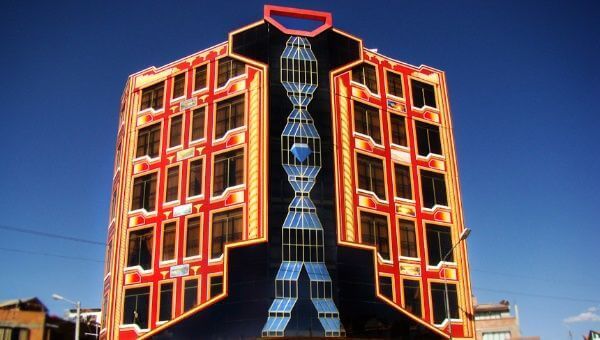
In Aymaran culture, there’s always a reason to celebrate. When native communities emigrate to cities, they take with them their Aymaran cultural traditions.
The ballrooms in Freddy Mamani’s designs are perfect for keeping these traditions alive. He truly did something grand by using architecture to house typical Aymaran customs.
These ballrooms are wide and extra tall. They also feature bars, dining areas, dance floors and stages for music groups. The mirrors reflect the light from walls and ceilings. In addition, the rooms also feature hanging light fixtures that are brought in all the way from China.
These ballrooms occupy the first floors of the buildings and the following floors are rented out. Most often than not, the tenants are the children of the building’s owners. In any case, the public spaces of the building are very well maintained. The beautiful exterior walls of the building tie all of the floors together.
Cholets – world recognition for opulent neo-Andean architecture
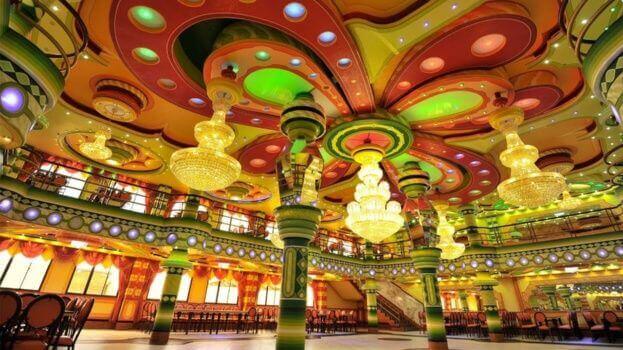
Only a few years ago, the documentary came out about the life and work of Freddy Mamani. It enjoyed success in the Rotterdam Documentary Film Festival and was titled Cholet: the world of Freddy Mamani and was directed by Isaac Niemand.
In addition, the Cartier Foundation commissioned Mamani to create a space for an Andean party for their Nomadic Nights event in 2018. The event was his moment to shine and take El Alto culture to Paris, engraving his cholets on the international wall of fame.
Bolivia’s Cultural Foundation of the Central Bank also prepared an exhibition of Freddy Mamani’s work in the La Paz National Museum of Art. Following the first showing, the exhibition has traveled to other cities throughout Bolivia, such as Sucre, Potosi, and Santa Cruz.
Cholets put opulent neo-Andean architecture on full display and are the treasure of the search for Aymaran architecture. The cultural identity has found a new expression thanks to Freddy Mamani’s work. Cholets are a fresh artistic expression that enriches Latin American art.
Cholets are a product of opulent Andean architecture. The buildings that arise from this neo-style are unmistakable thanks to their colors and geometric designs. In addition to their uniqueness, cholets have become a hot architecture trend in the Andean highlands.
The new style results from Freddy Mamani’s tireless search for a way to express contemporary Andean identity. Prior to becoming an engineer and builder, Mamani worked as a mason.
Freddy Mamani’s search focuses on the city of El Alto, which is located on the outskirts of La Paz, Bolivia. The rapidly-growing city is a product of the migration from the countryside of Bolivia.
More than fifty years ago, the first settlers made El Alto their home. Since then, a bourgeoisie Aymara population has been growing and growing. And Freddy Mamani is their choice architect.
Freddy Mamani, the self-taught architect

The Bolivian architect was born in the small Aymaran community of Catavi in the Aroma region of La Paz. He started working around 20 years ago as a mason’s assistant.
After his years in masonry, he decided to specialize and studied civil construction at the Universidad Mayor de San Andres. After completing his studies, he studied for a degree in Civil Engineering at the Universidad Bolivia de Informatica and studied architecture on his own.
The neo-Andean cholet style was on the road to success from the beginning. It all started when Francisco Mamani, a commercial telephone importer, wanted to construct a building. Without even knowing how he wanted to build it, he contacted Freddy Mamani.
Freddy then suggested building something elegant with Andean motifs and colors as well as a big room for events. The design implied a big change for the city as there would be no buildings like it. But, after its completion, there were more than 70 similar creations.
These buildings feature six levels and take center stage in El Alto’s urban scene. Their bright color palette is the first thing to catch the eye.
The colors are impossible to miss as the buildings in Al Alto are constructed with exposed bricks. The bricks create a monochrome, cold and dry backdrop for the city.
My architecture isn’t an exotic architecture; instead, it’s an Andean architecture that transmits identity and recuperates the essence of a culture.
–Freddy Mamani–
Cholets – the opulent neo-Andean architecture of the Aymaran Bourgeoisie

All through its history, El Alto has welcomed thousands of migrants from Bolivia’s countryside. More than fifty years of growth has armed a new Aymara upper-middle class.
This new class saw Freddy Mamani, and his services, as an exceptional talent. He found the Aymaran identity, architecture, and culture in his work. Freddy Mamani once stated, “I want to give my city identity by recovering the elements of our original culture.”
Cholets, which come from a mash-up of the Spanish words “chalet” (a type of house) and “cholo” (a term of national identity), now dot the Andean highlands. They feature large glass windows on exterior walls with plastic compositions of plaster molds.
The exterior walls feature spontaneous, modern geometric motifs in sweeps of complementary, bright colors. The most common colors are orange, green, blue and yellow.
Aymarans believe that homes are a universe in constant movement that should never stand still. Thus, they always need to be full of life through celebrations. Celebrations also bless with wealth, which helps the community. As a result, cholets are often buildings that serve multiple purposes.
These almost psychedelic-looking buildings actually draw their inspiration from the colors of aguayos. Aguayos are tapestries that Aymaran women use for a variety of uses.
But as a consequence following a cultural search instead of following academic standards, Freddy Mamani’s architecture received harsh criticism. In any case, the architect doesn’t seem to bat an eye and has stated, “I’ve broken the old architectonic norms and, yes, I am guilty.”
The Aymaran identity in cholet architecture

In Aymaran culture, there’s always a reason to celebrate. When native communities emigrate to cities, they take with them their Aymaran cultural traditions.
The ballrooms in Freddy Mamani’s designs are perfect for keeping these traditions alive. He truly did something grand by using architecture to house typical Aymaran customs.
These ballrooms are wide and extra tall. They also feature bars, dining areas, dance floors and stages for music groups. The mirrors reflect the light from walls and ceilings. In addition, the rooms also feature hanging light fixtures that are brought in all the way from China.
These ballrooms occupy the first floors of the buildings and the following floors are rented out. Most often than not, the tenants are the children of the building’s owners. In any case, the public spaces of the building are very well maintained. The beautiful exterior walls of the building tie all of the floors together.
Cholets – world recognition for opulent neo-Andean architecture

Only a few years ago, the documentary came out about the life and work of Freddy Mamani. It enjoyed success in the Rotterdam Documentary Film Festival and was titled Cholet: the world of Freddy Mamani and was directed by Isaac Niemand.
In addition, the Cartier Foundation commissioned Mamani to create a space for an Andean party for their Nomadic Nights event in 2018. The event was his moment to shine and take El Alto culture to Paris, engraving his cholets on the international wall of fame.
Bolivia’s Cultural Foundation of the Central Bank also prepared an exhibition of Freddy Mamani’s work in the La Paz National Museum of Art. Following the first showing, the exhibition has traveled to other cities throughout Bolivia, such as Sucre, Potosi, and Santa Cruz.
Cholets put opulent neo-Andean architecture on full display and are the treasure of the search for Aymaran architecture. The cultural identity has found a new expression thanks to Freddy Mamani’s work. Cholets are a fresh artistic expression that enriches Latin American art.







